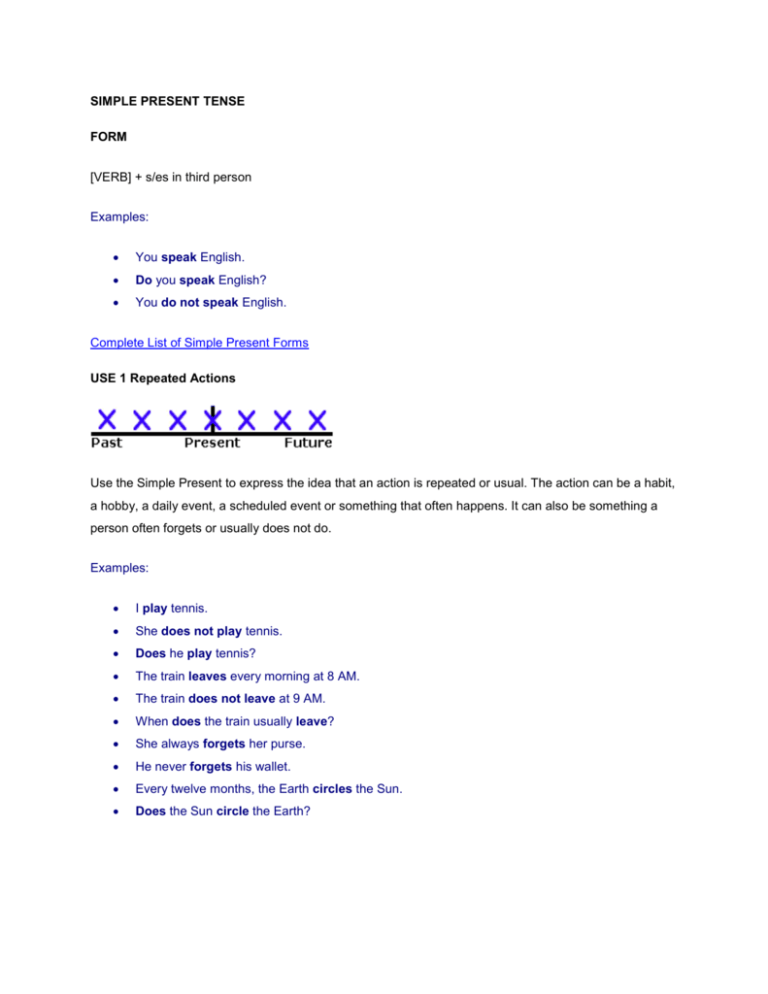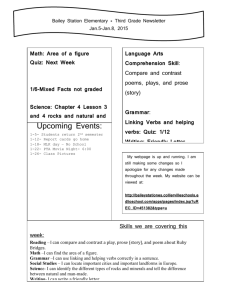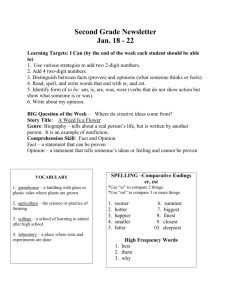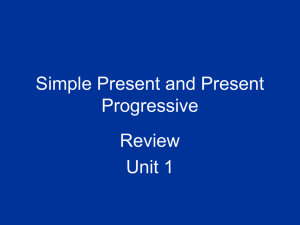File
advertisement

SIMPLE PRESENT TENSE FORM [VERB] + s/es in third person Examples: You speak English. Do you speak English? You do not speak English. Complete List of Simple Present Forms USE 1 Repeated Actions Use the Simple Present to express the idea that an action is repeated or usual. The action can be a habit, a hobby, a daily event, a scheduled event or something that often happens. It can also be something a person often forgets or usually does not do. Examples: I play tennis. She does not play tennis. Does he play tennis? The train leaves every morning at 8 AM. The train does not leave at 9 AM. When does the train usually leave? She always forgets her purse. He never forgets his wallet. Every twelve months, the Earth circles the Sun. Does the Sun circle the Earth? USE 2 Facts or Generalizations The Simple Present can also indicate the speaker believes that a fact was true before, is true now, and will be true in the future. It is not important if the speaker is correct about the fact. It is also used to make generalizations about people or things. Examples: Cats like milk. Birds do not like milk. Do pigs like milk? California is in America. California is not in the United Kingdom. Windows are made of glass. Windows are not made of wood. New York is a small city. It is not important that this fact is untrue. USE 3 Scheduled Events in the Near Future Speakers occasionally use Simple Present to talk about scheduled events in the near future. This is most commonly done when talking about public transportation, but it can be used with other scheduled events as well. Examples: The train leaves tonight at 6 PM. The bus does not arrive at 11 AM, it arrives at 11 PM. When do we board the plane? The party starts at 8 o'clock. When does class begin tomorrow? USE 4 Now (Non-Continuous Verbs) Speakers sometimes use the Simple Present to express the idea that an action is happening or is not happening now. This can only be done withNon-Continuous Verbs and certain Mixed Verbs. Examples: I am here now. She is not here now. He needs help right now. He does not need help now. He has his passport in his hand. Do you have your passport with you? ADVERB PLACEMENT The examples below show the placement for grammar adverbs such as: always, only, never, ever, still, just, etc. Examples: You only speak English. Do you only speak English? ACTIVE / PASSIVE Examples: Once a week, Tom cleans the car. Active Once a week, the car is cleaned by Tom. Passive PRESENT CONTINUOUS FORM [am/is/are + present participle] Examples: You are watching TV. Are you watching TV? You are not watching TV. Complete List of Present Continuous Forms USE 1 Now Use the Present Continuous with Normal Verbs to express the idea that something is happening now, at this very moment. It can also be used to show that something is not happening now. Examples: You are learning English now. You are not swimming now. Are you sleeping? I am sitting. I am not standing. Is he sitting or standing? They are reading their books. They are not watching television. What are you doing? Why aren't you doing your homework? USE 2 Longer Actions in Progress Now In English, "now" can mean: this second, today, this month, this year, this century, and so on. Sometimes, we use the Present Continuous to say that we are in the process of doing a longer action which is in progress; however, we might not be doing it at this exact second. Examples: (All of these sentences can be said while eating dinner in a restaurant.) I am studying to become a doctor. I am not studying to become a dentist. I am reading the book Tom Sawyer. I am not reading any books right now. Are you working on any special projects at work? Aren't you teaching at the university now? USE 3 Near Future Sometimes, speakers use the Present Continuous to indicate that something will or will not happen in the near future. Examples: I am meeting some friends after work. I am not going to the party tonight. Is he visiting his parents next weekend? Isn't he coming with us tonight? USE 4 Repetition and Irritation with "Always" The Present Continuous with words such as "always" or "constantly" expresses the idea that something irritating or shocking often happens. Notice that the meaning is like Simple Present, but with negative emotion. Remember to put the words "always" or "constantly" between "be" and "verb+ing." Examples: She is always coming to class late. He is constantly talking. I wish he would shut up. I don't like them because they are always complaining. REMEMBER Non-Continuous Verbs/ Mixed Verbs It is important to remember that Non-Continuous Verbs cannot be used in any continuous tenses. Also, certain non-continuous meanings for Mixed Verbs cannot be used in continuous tenses. Instead of using Present Continuous with these verbs, you must use Simple Present. Examples: She is loving this chocolate ice cream. Not Correct She loves this chocolate ice cream. Correct ADVERB PLACEMENT ACTIVE / PASSIVE The examples below show the placement for Examples: grammar adverbs such as: always, only, never, ever, still, just, etc. Right now, Tom is writing the letter. Active Examples: Right now, the letter is being written by Tom. Passive You are still watching TV. Are you still watching TV? REFERENCES: - http://www.englishpage.com/verbpage/verbs1.htm







